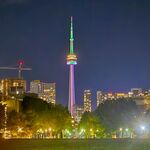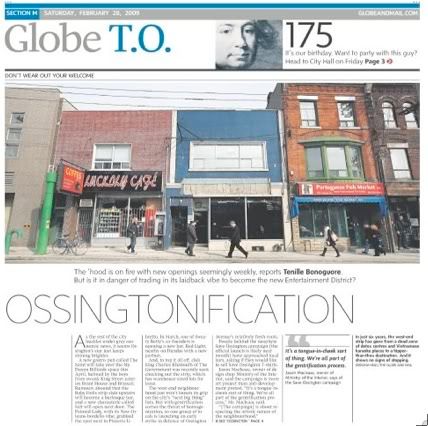M
mpolo2
Guest
(the Toronto Star)
Not so long ago, Ossington Ave. was dowdy and crime-ridden. Now, a few entrepreneurs are helping revitalize the westerly strip.
By Christopher Hutsul
Mar. 12, 2006. 07:14 AM
In late 2003, a group of shotgun-wielding men burst into an Ossington Ave. karaoke bar and opened fire, killing twin brothers and injuring three others. Police said the shootings appeared to be gang-related. Not long after the incident, the bar closed, and yet another empty storefront scarred the crime-riddled street.
Now, 2 1/2 years later, that space has reopened as The Sparrow, a trendy Asian-fusion restaurant. Where bullets once flew, red curry lentil soup is being served to urbanites savvy enough to venture beyond Queen West.
No other space better illustrates the changing face of Ossington. Until recently, this largely derelict commercial strip — which begins at Queen St. W. and extends north to Dundas St. W. — languished in a grim cycle of crime and murder. The residents, a reluctant coupling of Portuguese and Vietnamese immigrants, lived on edge.
After every shooting, and there were plenty, resentment between the ethnic groups deepened — though most agreed that the drug trade, a racket that rarely exists within one ethnic bubble, was the real culprit. Regardless of who was responsible, the consensus was that Ossington was sick.
Then, a few years ago, the Canadians starting showing up. The Canadians, which is the term Portuguese and Vietnamese shopkeepers use for white, non-ethnic anglophones, were seeking an alternative to high-rent Queen St. W., and they chose Ossington Ave. for their boutiques, bars and galleries.
This is where, in most stories about neighbourhoods in transition, one begins to groan about gentrification. But right now, the g-word is a non-topic on Ossington. Crime is down. Sidewalk traffic is up. Stores that were once empty shells, relics of a far gone vitality, are now selling flowers or pencil drawings. Though climbing property values (the Drake Hotel-art gallery strip is just around the corner) are threatening the comfort of artists who pioneered this territory, there's an air of optimism. Some say the Canadians serve as a cultural bridge between the Portuguese and the Vietnamese people. And most people would prefer to see yuppies lurking about instead of gunmen.
Today, two Canadians are eating pad Thai at The Golden Turtle, a friendly Vietnamese restaurant at the corner of Ossington and Argyle St. (chef Susur Lee, who lives nearby, is said to be a regular). Selena and Pol Cristo-Williams, recently married, are part of a small band of entrepreneurs who are transforming the street. In 2001, Selena was forced to relocate her Queen St. W. gallery — since replaced by the Beaver Café — and chose Ossington in favour of somewhere west of the Dufferin underpass. In 2004, she and Pol converted the gallery into Sweaty Betty's, a tiny booze parlour. In November, they teamed up with chef Michael Brennan to launch The Sparrow.
"Ossington was a gamble," says Selena. "There was the violence, but there was also no walk-by traffic. You had to be a destination for people to come up here. I was just hoping that sooner or later, things would develop."
So far, the gamble has paid off. The Sparrow is one of about a dozen young businesses that are feeding off each other by bringing new visitors to the strip. In the past few years, the street has been graced by the arrival of the Yoga Space, organic eatery Get Real, the Crooked Star pub, and a handful of art galleries and vintage shops. The accidental collective is beginning to lure new bodies away from Queen's West beaten path.
Which is an accomplishment. Ossington's ramshackle southerly base is tarnished by the bunker-like façade of the Centre for Addiction and Mental Health. The area is complicated by the omnipresence of the facility's troubled, if innocuous, clients, and those who frequent the nearby University Health Network detox centre. The street is a hodgepodge of run-down Victorian commercial spaces, automotive shops, and light-industrial facilities, some of which appear to be defunct. A few years ago, a large automotive complex was demolished to make space for a large, plain townhouse complex. Though the project has enlivened the area, it's added nothing to the streetscape.
To the north, Ossington fleshes out with older, more established businesses, including the Peixaria Portugal fish market, the cozy Columbia Bakery, and the notorious Baby Dolls Strip club. At Dundas, Ossington's commercial strip comes to an abrupt end, and the street turns residential to the north.
If Ossington has a legacy, it's one of industriousness. The strip's dotted with tire shops, hardware stores and kitchen cabinet outlets. It was once home to a luggage factory. In the western alley, a Portuguese bakery hums through the night (it's a local tradition, apparently, to pick up a warm loaf on the way home from Baby Dolls).
Downtown Lumber has been a hub of activity for decades. Antonio Santos, who's worked there for nearly 30 years, likes the direction the street's going. He remembers when, in 1990, he came to work and saw a bullet hole in the window above the front door. Once again, there'd been gunplay at the gas bar across the street. He doesn't expect to see any bullets coming from those crisp new townhouses. "Now it's much better," he says. "The people are different. It's quieter."
All this is especially good for the real-estate business. A commercial space at the corner of Ossington and Humbert St. sold last week for a reported $1.1 million. Landlords have picked up on the Ossington buzz and are adjusting lease rates accordingly. James Fortier, who owns i deal coffee in Kensington Market, pounced on a space before costs became prohibitive. He expects to open his bright, spacious shop this weekend (look for artist Kelly Palmer's hand-painted wall embellishments).
"I regret not jumping in here when prices were lower," says Fortier. "I'm betting that if I'd signed on a year ago, my lease would be at least half what it is right now. The rents have doubled already."
Dani (who asked that her last name be withheld) sells flowers and antiques at Cindiloowho, and she hopes rising rents will be offset by higher margins. When she relocated to Ossington 2 1/2 years ago, her business was based on word-of-mouth as opposed to street traffic. Saturday was her slowest day of the week. All that's changed now.
"It was a vast wasteland, a dark little corner of the city waiting to be tapped into," she laughs, as Maico from Get Real drops off a snack: a sandwich topped with melted Brie.
"You hope as someone who's been here all along, that in three years you can still afford it," says Dani. "I helped develop it, and ... I hope I can grow with it."
Inside the legendary Venezia Bakery, schoolchildren line up for an after-school snack — fries and Pepsi cost only $2.25. A group of Vietnamese-Canadians huddle around a table and drink tall, sweet coffees out of Styrofoam cups. At another table sits owner Maria Caetano, and Argyle St. crossing guard Gertrude Kolthoff, who's been warming up here between shifts for 30 years (she loves the honey buns). When Maria and her husband, John, both Portuguese immigrants, took over the store from its original Italian owners in 1980, they decided to keep the name. Today, Maria is enjoying a new wave of business. She sells coffee and custard tarts to the women from the Yoga studio up the street.
"It's better since the Canadians moved in," she says. "There are good people coming in the stores."
"But I've always loved Ossington. It's a good street. Everyone always loves the first street they lived on when they first move to Canada. There's a hospital nearby, the bus, a pharmacy ... It has everything I need."
And less of what she and others don't, namely crime. Where it went exactly is up for debate. Some say it has to do with the increased pedestrian traffic: thugs, naturally, don't like an audience. Others say the drop in crime is a result of Ossington's new higher wattage streetlights — yet another deterrent to the criminal element. The city also changed the parking laws on Ossington: a permit is now required to park overnight. In other words, troublemaking outsiders are less inclined to linger.
Sgt. Daryle Gerry of 14 Division, who patrols the strip by bicycle, says the new condos have had a positive effect on the street's chemistry.
"It was notorious for the shootings in the karaoke bars — there was a Vietnamese gang atmosphere," says Gerry, who's a big fan of the chicken at Alex Rei Dos Leitoes on Ossington. "But since 2003, it's gotten a lot better. With the new condos, it seems to be uplifting. Anything like that is going to improve the area. And it's getting revamped down by Queen. There's not a lot of crime happening there now."
Seventeen-year-old Linda Nguyen, daughter of the Golden Turtle's proprietors, has a theory of her own. Linda thinks the 2003 double murder — the victims were her best friend's brothers — was a turning point for the community. That's when everyone, Vietnamese and Portuguese alike, decided that enough was enough.
"Since that incident, no one sells drugs in the alleyways," says Linda. "It's just over. Nobody wanted to be a part of that. People started watching the neighbourhood now."
No one is happier about that than Linda, who felt, growing up, that her Portuguese neighbours blamed her people for the illicit activity. She remembers hearing the accusatory whispers as she walked home from school. Linda says that with the new sense of optimism on Ossington, and with the arrival of new faces and business opportunities, there's a new levity between the ethnic groups.
"People are growing out of being racist," she says. "Now that we have people from different parts of Canada, people are walking by our restaurant and seeing that it isn't just Vietnamese people eating here, so they want to check it out. Now Portuguese people are coming into our restaurant to try our food."
"A.W.O.L. Gallery, the Crooked Star, the Sparrow, it's all great," she says. "It gives us a more diverse community instead of just being two different cultures.
Ossington Ave. finds itself in transition. Down, but never out, it's being guided into the future by an unlikely coalition of established ethnic groups and progressive entrepreneurs. The downside to all this is higher rents and real estate and, potentially, an increased corporate presence, along with an exodus of the very people responsible for its revival.
But with any luck, those who'd threaten the spirit of this blossoming strip will pull up to the foot of Ossington Ave., see the boarded-up windows and the detox centre, recall Ossington's legacy of crime, and keep on driving.
If that happens, Ossington Ave. will have dodged yet another bullet.
Not so long ago, Ossington Ave. was dowdy and crime-ridden. Now, a few entrepreneurs are helping revitalize the westerly strip.
By Christopher Hutsul
Mar. 12, 2006. 07:14 AM
In late 2003, a group of shotgun-wielding men burst into an Ossington Ave. karaoke bar and opened fire, killing twin brothers and injuring three others. Police said the shootings appeared to be gang-related. Not long after the incident, the bar closed, and yet another empty storefront scarred the crime-riddled street.
Now, 2 1/2 years later, that space has reopened as The Sparrow, a trendy Asian-fusion restaurant. Where bullets once flew, red curry lentil soup is being served to urbanites savvy enough to venture beyond Queen West.
No other space better illustrates the changing face of Ossington. Until recently, this largely derelict commercial strip — which begins at Queen St. W. and extends north to Dundas St. W. — languished in a grim cycle of crime and murder. The residents, a reluctant coupling of Portuguese and Vietnamese immigrants, lived on edge.
After every shooting, and there were plenty, resentment between the ethnic groups deepened — though most agreed that the drug trade, a racket that rarely exists within one ethnic bubble, was the real culprit. Regardless of who was responsible, the consensus was that Ossington was sick.
Then, a few years ago, the Canadians starting showing up. The Canadians, which is the term Portuguese and Vietnamese shopkeepers use for white, non-ethnic anglophones, were seeking an alternative to high-rent Queen St. W., and they chose Ossington Ave. for their boutiques, bars and galleries.
This is where, in most stories about neighbourhoods in transition, one begins to groan about gentrification. But right now, the g-word is a non-topic on Ossington. Crime is down. Sidewalk traffic is up. Stores that were once empty shells, relics of a far gone vitality, are now selling flowers or pencil drawings. Though climbing property values (the Drake Hotel-art gallery strip is just around the corner) are threatening the comfort of artists who pioneered this territory, there's an air of optimism. Some say the Canadians serve as a cultural bridge between the Portuguese and the Vietnamese people. And most people would prefer to see yuppies lurking about instead of gunmen.
Today, two Canadians are eating pad Thai at The Golden Turtle, a friendly Vietnamese restaurant at the corner of Ossington and Argyle St. (chef Susur Lee, who lives nearby, is said to be a regular). Selena and Pol Cristo-Williams, recently married, are part of a small band of entrepreneurs who are transforming the street. In 2001, Selena was forced to relocate her Queen St. W. gallery — since replaced by the Beaver Café — and chose Ossington in favour of somewhere west of the Dufferin underpass. In 2004, she and Pol converted the gallery into Sweaty Betty's, a tiny booze parlour. In November, they teamed up with chef Michael Brennan to launch The Sparrow.
"Ossington was a gamble," says Selena. "There was the violence, but there was also no walk-by traffic. You had to be a destination for people to come up here. I was just hoping that sooner or later, things would develop."
So far, the gamble has paid off. The Sparrow is one of about a dozen young businesses that are feeding off each other by bringing new visitors to the strip. In the past few years, the street has been graced by the arrival of the Yoga Space, organic eatery Get Real, the Crooked Star pub, and a handful of art galleries and vintage shops. The accidental collective is beginning to lure new bodies away from Queen's West beaten path.
Which is an accomplishment. Ossington's ramshackle southerly base is tarnished by the bunker-like façade of the Centre for Addiction and Mental Health. The area is complicated by the omnipresence of the facility's troubled, if innocuous, clients, and those who frequent the nearby University Health Network detox centre. The street is a hodgepodge of run-down Victorian commercial spaces, automotive shops, and light-industrial facilities, some of which appear to be defunct. A few years ago, a large automotive complex was demolished to make space for a large, plain townhouse complex. Though the project has enlivened the area, it's added nothing to the streetscape.
To the north, Ossington fleshes out with older, more established businesses, including the Peixaria Portugal fish market, the cozy Columbia Bakery, and the notorious Baby Dolls Strip club. At Dundas, Ossington's commercial strip comes to an abrupt end, and the street turns residential to the north.
If Ossington has a legacy, it's one of industriousness. The strip's dotted with tire shops, hardware stores and kitchen cabinet outlets. It was once home to a luggage factory. In the western alley, a Portuguese bakery hums through the night (it's a local tradition, apparently, to pick up a warm loaf on the way home from Baby Dolls).
Downtown Lumber has been a hub of activity for decades. Antonio Santos, who's worked there for nearly 30 years, likes the direction the street's going. He remembers when, in 1990, he came to work and saw a bullet hole in the window above the front door. Once again, there'd been gunplay at the gas bar across the street. He doesn't expect to see any bullets coming from those crisp new townhouses. "Now it's much better," he says. "The people are different. It's quieter."
All this is especially good for the real-estate business. A commercial space at the corner of Ossington and Humbert St. sold last week for a reported $1.1 million. Landlords have picked up on the Ossington buzz and are adjusting lease rates accordingly. James Fortier, who owns i deal coffee in Kensington Market, pounced on a space before costs became prohibitive. He expects to open his bright, spacious shop this weekend (look for artist Kelly Palmer's hand-painted wall embellishments).
"I regret not jumping in here when prices were lower," says Fortier. "I'm betting that if I'd signed on a year ago, my lease would be at least half what it is right now. The rents have doubled already."
Dani (who asked that her last name be withheld) sells flowers and antiques at Cindiloowho, and she hopes rising rents will be offset by higher margins. When she relocated to Ossington 2 1/2 years ago, her business was based on word-of-mouth as opposed to street traffic. Saturday was her slowest day of the week. All that's changed now.
"It was a vast wasteland, a dark little corner of the city waiting to be tapped into," she laughs, as Maico from Get Real drops off a snack: a sandwich topped with melted Brie.
"You hope as someone who's been here all along, that in three years you can still afford it," says Dani. "I helped develop it, and ... I hope I can grow with it."
Inside the legendary Venezia Bakery, schoolchildren line up for an after-school snack — fries and Pepsi cost only $2.25. A group of Vietnamese-Canadians huddle around a table and drink tall, sweet coffees out of Styrofoam cups. At another table sits owner Maria Caetano, and Argyle St. crossing guard Gertrude Kolthoff, who's been warming up here between shifts for 30 years (she loves the honey buns). When Maria and her husband, John, both Portuguese immigrants, took over the store from its original Italian owners in 1980, they decided to keep the name. Today, Maria is enjoying a new wave of business. She sells coffee and custard tarts to the women from the Yoga studio up the street.
"It's better since the Canadians moved in," she says. "There are good people coming in the stores."
"But I've always loved Ossington. It's a good street. Everyone always loves the first street they lived on when they first move to Canada. There's a hospital nearby, the bus, a pharmacy ... It has everything I need."
And less of what she and others don't, namely crime. Where it went exactly is up for debate. Some say it has to do with the increased pedestrian traffic: thugs, naturally, don't like an audience. Others say the drop in crime is a result of Ossington's new higher wattage streetlights — yet another deterrent to the criminal element. The city also changed the parking laws on Ossington: a permit is now required to park overnight. In other words, troublemaking outsiders are less inclined to linger.
Sgt. Daryle Gerry of 14 Division, who patrols the strip by bicycle, says the new condos have had a positive effect on the street's chemistry.
"It was notorious for the shootings in the karaoke bars — there was a Vietnamese gang atmosphere," says Gerry, who's a big fan of the chicken at Alex Rei Dos Leitoes on Ossington. "But since 2003, it's gotten a lot better. With the new condos, it seems to be uplifting. Anything like that is going to improve the area. And it's getting revamped down by Queen. There's not a lot of crime happening there now."
Seventeen-year-old Linda Nguyen, daughter of the Golden Turtle's proprietors, has a theory of her own. Linda thinks the 2003 double murder — the victims were her best friend's brothers — was a turning point for the community. That's when everyone, Vietnamese and Portuguese alike, decided that enough was enough.
"Since that incident, no one sells drugs in the alleyways," says Linda. "It's just over. Nobody wanted to be a part of that. People started watching the neighbourhood now."
No one is happier about that than Linda, who felt, growing up, that her Portuguese neighbours blamed her people for the illicit activity. She remembers hearing the accusatory whispers as she walked home from school. Linda says that with the new sense of optimism on Ossington, and with the arrival of new faces and business opportunities, there's a new levity between the ethnic groups.
"People are growing out of being racist," she says. "Now that we have people from different parts of Canada, people are walking by our restaurant and seeing that it isn't just Vietnamese people eating here, so they want to check it out. Now Portuguese people are coming into our restaurant to try our food."
"A.W.O.L. Gallery, the Crooked Star, the Sparrow, it's all great," she says. "It gives us a more diverse community instead of just being two different cultures.
Ossington Ave. finds itself in transition. Down, but never out, it's being guided into the future by an unlikely coalition of established ethnic groups and progressive entrepreneurs. The downside to all this is higher rents and real estate and, potentially, an increased corporate presence, along with an exodus of the very people responsible for its revival.
But with any luck, those who'd threaten the spirit of this blossoming strip will pull up to the foot of Ossington Ave., see the boarded-up windows and the detox centre, recall Ossington's legacy of crime, and keep on driving.
If that happens, Ossington Ave. will have dodged yet another bullet.





